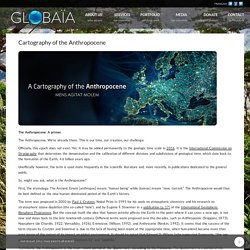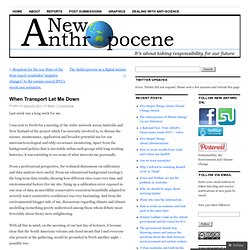

A World of Cities. Within a human lifetime, the face of Earth has been transformed.

Cities now dominate the landscape, and even if people disappeared tomorrow, cities would remain one of the Anthropocene’s most visible and enduring legacies. In 1950, only 29% of people lived in cities. Today more than half do, and that proportion is expected to reach 70% by 2050. In 2008, the global urban population exceeded the number of people dwelling in the country for the first time in history. By 2025, there will be about 600 cities of a million people or more. Recently, urban growth has shifted from Europe and South America to Asia and Africa.
Historically, cities had to be sited near water and fertile land. This frenetic urban growth is a big cause of environmental change. Anthropocene-cities-and-transport. A Cartography of the Anthropocene. The Anthropocene: A primer.

The Anthropocene. We’re already there. This is our time, our creation, our challenge. Officially, this epoch does not exist. Yet. Unofficially however, the term is used more frequently in the scientific literature and, more recently, in publications dedicated to the general public. So, might you ask, what is the Anthropocene? Conservation in the Anthropocene. Read a summary of this article here.

By its own measures, conservation is failing. Biodiversity on Earth continues its rapid decline. We continue to lose forests in Africa, Asia, and Latin America. There are so few wild tigers and apes that they will be lost forever if current trends continue. Simply put, we are losing many more special places and species than we're saving. Ironically, conservation is losing the war to protect nature despite winning one of its hardest fought battles -- the fight to create parks, game preserves, and wilderness areas. But while conservation has historically been locally driven -- focused on saving specific places such as Yosemite National Park and the Grand Canyon, or on managing very limited ecological systems like watersheds and forests -- its more recent ambitions have become almost fantastical.
In the face of these realities, 21st century conservation is changing. 1. In many parts of the world, parks have become anathema to conservation. The Anthropocene: A man-made world. NclRIBAcchange. When Transport Let Me Down « New Anthropocene. Last week was a long week for me.

I was sent to Perth for a meeting of the wider network across Australia and New Zealand of the project which I’m currently involved in, to discuss the science, maintenance, application and broader potential use for our micrometeorological and eddy covariance monitoring. Apart from the background politics that is inevitable within such groups with long working histories, it was enriching to see some of what interests me personally. From a professional perspective, the technical discussions on calibration and data analysis were useful. From my educational background (ecology), the long term data results, showing how different sites react over time and environmental factors (for my site, fixing up a calibration error exposed in our year of data an incredibly conservative ecosystem beautifully adapted to severely water constrictive conditions) was very fascinating. Of course, in itself, this is no bad thing.
However, within me casual musing persisted.